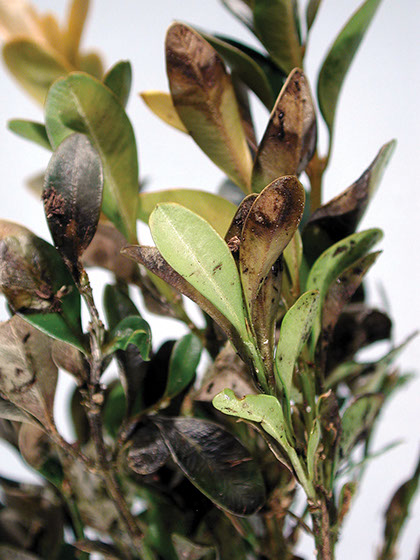
Summer 2019
Boxwood Blight is Here
What you can do to protect your shrubs...
Boxwood (Buxus sp.), because of its vibrant green color and woody evergreen growth, is an important but frequently over-utilized ornamental shrub on some landscapes. It is known to get infected by a number of plant diseases, including boxwood blight, boxwood dieback, macrophoma blight, phytophthora root rot and Volutella blight, as well as some common pests such as boxwood leafminer and psyllid. Boxwood blight however is by far the most serious of these issues and we are seeing a surge in our region.
What is Boxwood Blight?
Boxwood Blight is a relatively new fungal disease that has only been around globally since 1994. It was first seen in the U.S. in 2011 in Connecticut and North Carolina. Since then, it has spread to several other states and Canada. Recently, this disease has become particularly widespread in Westchester County (NY), Fairfield County (CT) and Bergen County (NJ) landscapes. It is caused by Calonectria pseudonaviculata, a fungus that can be confused with similar-looking forms of dieback in boxwood. However, Boxwood Blight is much more devastating and can take out complete plantings. The spores can also be transmitted through pachysandra, which is also a host.
How do you identify Boxwood Blight?
You can identify Boxwood Blight by dark or light brown spots on the leaves and dieback on stems girdled by black cankers (see image). This is followed by severe leaf drop, either on a section of the shrub or the entire shrub.
Can Boxwood Blight be treated?
Boxwood Blight cannot be eliminated with fungicides but it can be treated to slow its spread to healthy plants. Whether or not your boxwood dies from the infection depends on plant vigor, weather, and factors such as irrigation type and shading. Even if not entirely killed, a shrub’s value as an ornamental is often destroyed by boxwood blight. The best course of action is to remove and destroy the infected shrubs, as well as all of the leaves and top 1/2 inch of soil and stump. Scientists are recommending that diseased plants and leaves be sanitarily removed and not used for composting, since the fungus can stay in dead leaves for up to 5 years. The removed shrubs, leaves and soil should be placed in a thick plastic bag and sent off for incineration.
Can I protect my Boxwood shrubs from Boxwood Blight?
There is no guaranteed program to prevent or treat Boxwood Blight. However, there are careful maintenance practices that can be followed to decrease its spread. They include proper trimming and pruning techniques as well as being on an annual plant health care program. It is best to prune Boxwood in spring and to avoid pruning it in fall or winter. If you already have a valuable boxwood collection, do not introduce new boxwood to your property unless it is from a trusted source. And, only use clean and disinfected pruning tools when shearing or pruning your shrubs.
If you have any additional questions about Boxwood Blight or other plant diseases, please call and schedule a visit with an Almstead arborist.


LOCATIONS:
Lower Westchester County, NY and New York City
58 Beechwood Ave, New Rochelle, NY 10801
914-576-0193
Upper Westchester (North of I-287)
15 Broadway, Hawthorne, NY 10532
914-741-1510
Fairfield County, Connecticut
547 Hope Street, Stamford CT 06907
203-348-4111
Bergen & Passaic Counties, NJ
504 High Mountain Road, North Haledon, NJ 07508
973-636-6711
Contact us for a Free Consultation